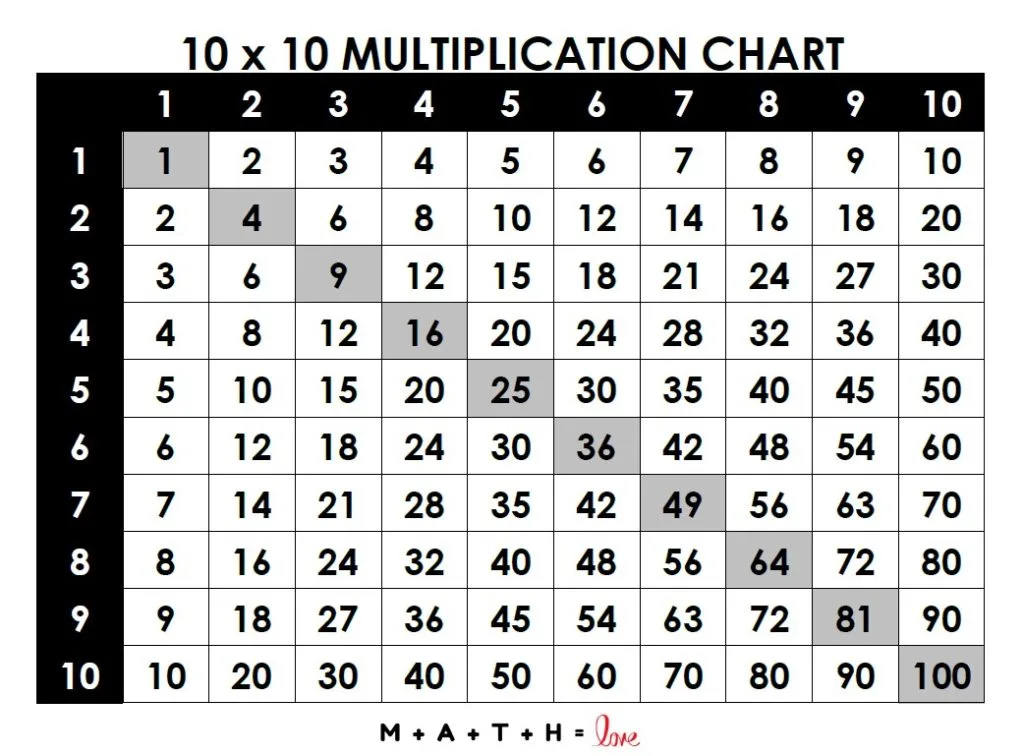MATHS
Welcome to the Parent area of the St Joseph’s Catholic Primary 'Maths Zone'. Here you will find the calculation guidance booklets to help you understand how your child learns to calculate at St Joseph’s. There is also a link to the statutory requirements for the teaching and learning of mathematics and the long-term plan for each year group. There are also lots of resources to help your child’s Maths learning at home.
Calculation guides
Click on the calculation symbols for a link to each booklet.
National Curriculum
Please CLICK HERE for the statutory requirements for the teaching and learning of mathematics from September 2014 as outlined in the most recent version of the updated National Curriculum.
MATHS VOCABULARY
A lot of the time mathematics is confusing because of the language which is included in the maths. For example when a teacher says 'Draw a table' should it look like this
 OR
OR 
This Maths website is great if you are not sure about what a term actually means (click on the image to go to the page):
Maths at Home
Maths is essential to everyday life and, as such, it is important for children to see and experience how it can be useful in their own world. Below are some ideas for how you can support your child's learning at home and help them to develop their sense of curiosity and enjoyment of mathematics as well as develop the skills which will help them in their everyday life.

Calculation
The maths work your child is doing at school may look very different to the kind of ‘sums’ you remember. This is because children are encouraged to work mentally, where possible, using personal jottings to help support their thinking. Even when children are taught more formal written methods (from late year 3 onwards), they are only encouraged to use these methods for calculations they cannot solve in their heads.
When faced with a calculation problem, encourage your child to ask…
· Can I do this in my head?
· Could I do this in my head using drawings or jottings to help me?
· Do I need to use a written method?
· Should I use a calculator?
Also help your child to estimate and then check the answer. Encourage them to ask…
Is the answer sensible?

Real Life Problems
· Go shopping with your child to buy two or three items. Ask them to work out the total amount spent and how much change you will get.
· Buy some items with a percentage extra free. Help your child to calculate how much of the product is free.
· Plan an outing during the holidays. Ask your child to think about what time you will need to set off, how long it will take, what time you will arrive and how much money you will need to take.
· Use a TV guide. Ask your child to work out the length of their favourite programmes. Can they calculate how long they spend watching TV each day / week?
· Use a bus or train timetable. Ask your child to work out how long a journey between two places should take? Go on the journey. Do you arrive earlier or later than expected? How much earlier/later?
· Help your child to scale a recipe up or down to feed the right amount of people.
· Work together to plan a party or meal on a budget.
These are just a few ideas to give you a starting point. Try to involve your child in as many problem-solving activities as possible. The more ‘real’ a problem is, the more motivated they will be when trying to solve it.

Counting Ideas
-
Practise chanting the number names. Encourage your child to join in with you. When they are confident, try starting from different numbers - 4, 5, 6 . . .
-
Sing number rhymes together - there are lots of commercial mp3s and CDs available.
-
Give your child the opportunity to count a range of interesting objects (coins, pasta shapes, buttons etc.). Encourage them to touch and move each object as they count.
-
Count things you cannot touch or see (more difficult!!). Try lights on the ceiling, window panes, jumps, claps or oranges in a bag.
-
Play games that involve counting (e.g. snakes and ladders, dice games, games that involve collecting objects).
-
Look for numerals in the environment. You can spot numerals at home, in the street or when out shopping.
-
Cut out numerals from newspapers, magazines or birthday cards. Then help your child to put the numbers in orders.
-
Make mistakes when chanting, counting or ordering numbers. Can your child spot what you have done wrong?
-
Choose a number of the week e.g. 5. Practise counting to 5 and on from 5. Count out groups of 5 objects (5 dolls, 5 bricks, 5 pens). See how many places you can spot the numeral 5.

Practising Number Facts
-
Find out which number facts your child is learning at school (addition facts to 10, times tables, doubles etc). Try to practise for a few minutes each day using a range of vocabulary.
-
Have a ‘fact of the day’. Pin this fact up around the house. Practise reading it in a quiet, loud, squeaky voice. Ask your child over the day if they can recall the fact.
-
Play ‘ping pong’ to practise complements with your child. You say a number. They reply with how much more is needed to make 10. You can also play this game with numbers totalling 20, 100 or 1000. Encourage your child to answer quickly, without counting or using fingers.
-
Throw 2 dice. Ask your child to find the total of the numbers (+), the difference between them (-) or the product (x). Can they do this without counting?
-
Use a set of playing cards (no pictures). Turn over two cards and ask your child to add or multiply the numbers. If they answer correctly, they keep the cards. How many cards can they collect in 2 minutes?
-
Play Bingo. Each player chooses five answers (e.g. numbers to 10 to practise simple addition, multiples of 5 to practise the five times tables). Ask a question and if a player has the answer, they can cross it off. The winner is the first player to cross off all their answers.
-
Give your child an answer. Ask them to write as many addition sentences as they can with this answer (e.g. 10 = 8 + 2). Try with multiplication or subtraction.
-
Give your child a number fact (e.g. 5+3=8). Ask them what else they can find out from this fact (e.g. 3+5=8, 8-5=3, 8-3=5, 50+30=80, 500+300=800, 5+4=9, 15+3=18). Add to the list over the next few days. Try starting with a x fact as well.

Shape, Space and Measures
-
Choose a shape of the week e.g. cylinder. Look for this shape in the environment (tins, candles etc). Ask your child to describe the shape to you (2 circular faces, 2 curved edges ...)
-
Play ‘guess my shape’. You think of a shape. Your child asks questions to try to identify it but you can only answer ‘yes’ or ‘no’ (e.g. Does it have more than 4 corners? Does it have any curved sides?)
-
Hunt for right angles around your home. Can your child also spot angles bigger or smaller than a right angle?
-
Look for symmetrical objects. Help your child to draw or paint symmetrical pictures / patterns?
-
Make a model using boxes/containers of different shapes and sizes. Ask your child to describe their model.
-
Practise measuring the lengths or heights of objects (in metres or cm). Help your child to use different rulers and tape measures correctly. Encourage them to estimate before measuring.
-
Let your child help with cooking at home. Help them to measure ingredients accurately using weighing scales or measuring jugs. Talk about what each division on the scale stands for.
-
Choose some food items out of the cupboard. Try to put the objects in order of weight, by feel alone. Check by looking at the amounts on the packets.
-
Practise telling the time with your child. Use both digital and analogue clocks. Ask your child to be a ‘timekeeper’ (e.g. tell me when it is half past four because then we are going swimming).
-
Use a stop clock to time how long it takes to do everyday tasks (e.g. how long does it take to get dressed?). Encourage your child to estimate first.











